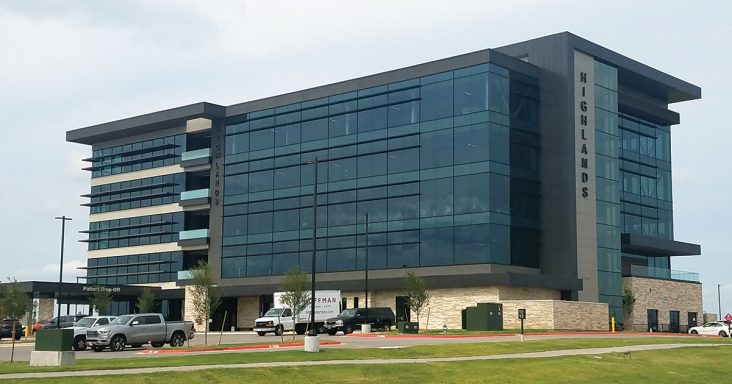Highlands Oncology Group opens $30M Springdale center
by October 1, 2020 12:03 pm 4,827 views

The Highlands Oncology Group building is the first building out of the ground in a 27-acre commercial project called Parkway Plaza, led by Cushman & Wakefield/Sage Partners in Rogers and Griffin Co. Realtors of Springdale. The site is at the southeast corner of Don Tyson Parkway and Gene George Boulevard, west of Interstate 49 in Springdale.
Highlands Oncology Group (HOG) opened a 125,000-square-foot building in Springdale in August. Jeff Hunnicutt said the benefit is twofold: for HOG as an organization and its patients.
Hunnicutt was hired in October 2018 as HOG’s first chief executive officer. He said the five-story building, estimated at $30 million and built by Fayetteville contractor C.R. Crawford Construction, and designed by Crafton Tull of Rogers, will help HOG streamline several operations previously spread throughout multiple buildings in Fayetteville, a byproduct of piecemeal growth.
“Administration was in one [building], the business office was in another,” Hunnicutt said. “Physical therapy was in one [building], and our chest clinic was in another. We were scattered in six or seven different buildings in a 0.5-mile radius because we kept growing.”
Hunnicutt said HOG’s medical oncology and radiation oncology therapies will remain at the clinical site in Fayetteville.
“Everything else is coming into this [Springdale] building,” Hunnicutt said. “For me, selfishly, it’s nice to walk through the halls on five different floors and connect with staff members every day. It’s a very good thing to build a rapport with the staff and build those relationships.”
Highlands is a group of independent physicians specializing in medical oncology, radiation oncology, palliative care and specialty surgery. It originated in 1996 with medical oncologists Thaddeus Beck, Daniel Bradford and Malcolm Hayward and is one of the most extensive cancer treatment and research centers in Arkansas, with approximately 450 employees. Among its 20 physicians are 11 medical oncologists, three radiation oncologists, two palliative care doctors and five surgeons in various specialties.
Hunnicutt said about 250 employees will work in the Springdale building, which saw its first patients Aug. 24. It includes 48 infusion chairs and 34 exam rooms. The provider’s Rogers clinic opened in 2011 and has an additional 40 infusion chairs and 24 exam rooms.
Hunnicutt said the Springdale building will also house HOG’s research department, led by Beck. He’s an accredited author of more than 90 papers and abstracts and played a role in launching HOG’s clinical trials program.
“We have 25 research employees who have been scattered between three or four different sites,” Hunnicutt said. “Having them together and the coordination and efficiency that will come out of that is going to be dramatic. It will allow us to get more patients on [a] study quicker. And, consequently, more studies in-house, too. It will be better for the community.”
The American Cancer Society forecasts that 1.8 million new cancer cases will be diagnosed in 2020. In Arkansas, a cancer diagnosis is expected to be given to 17,200 people this year.
POSITIONED FOR GROWTH
The HOG building is the first building out of the ground in a 27-acre commercial project called Parkway Plaza, led by Cushman & Wakefield/Sage Partners in Rogers and Griffin Co. Realtors of Springdale.
In September 2018, Highlands completed a $3.2 million purchase of 8 acres off Interstate 49, at the southeast corner of Don Tyson Parkway and Gene George Boulevard. The site is almost halfway between Highlands’ Fayetteville location on North Hills Boulevard and Rogers’ newer location, north of Pinnacle Hills.
Hunnicutt said by the end of 2020, HOG will occupy most of the Springdale building’s five floors, with an eye toward the future. The facility is “significantly bigger” than the provider needs right now. But in one of the fastest-growing regions in the country, space will be at a premium in the future. Look no further than HOG’s piecemeal office growth in Fayetteville during the past two decades to see that.

“It’s a credit to the owners of the building that they had the vision to look ahead further than five years,” Hunnicutt said. “We know this area is showing no signs of slowing down. It positions us well to continue providing the care to patients here for the foreseeable future. It’s also an attractive feature for recruiting high-quality physicians.”
A smaller group of physician owners owns each of HOG’s buildings.
Hunnicutt said there’s about 13,000 square feet available for lease in Springdale. He said there have been “very good discussions” with a couple of potential tenants, but no agreements are signed yet.
“Ideally, our goal is to try and keep the entire building focused on healthcare,” he said. “If it relates to oncology, that’s great. Or if it’s something in common referral to us to another type of specialty.”
An example of that type of tenant will be on the first floor. Hunnicutt said Fayetteville-based Medical Associates of Northwest Arkansas (MANA) will open a fourth location of The Breast Center in a 1,800-square-foot space. It will join MANA’s existing breast cancer screening clinics in Fayetteville, Rogers and Harrison.
Hunnicutt also noted HOG’s location in Springdale’s expanding medical corridor along the interstate near the Don Tyson Parkway exit. Arkansas Children’s Northwest opened a 234,000-square-foot hospital in February 2018. North of the hospital on Gene George Boulevard, a five-story, 80,000-square-foot medical office building is under construction, called Center for Children’s Health & Wellness.
Also in the area, a four-story, 76,000-square-foot medical office building is under construction for Little Rock-based USAble Corp., a wholly-owned subsidiary of Arkansas Blue Cross and Blue Shield.
Nabholz Corp. is building both buildings, which are scheduled to be completed in 2021.
PROTON PLANNING
Hunnicutt said HOG is also planning to buy adjacent land in Parkway Plaza to accommodate future growth. He said something that is very much on the horizon for HOG is proton therapy, a type of radiation therapy not yet offered in Northwest Arkansas.
According to the Mayo Clinic, radiation therapy using X-rays has long been used to treat cancers and noncancerous (benign) tumors. Proton therapy is a newer type of radiation therapy that uses energy from positively charged particles called protons.
Proton therapy has shown promise in treating several kinds of cancer, the Mayo Clinic said. Studies have suggested that proton therapy may cause fewer side effects than traditional radiation since doctors can better control where the proton beams deposit their energy. But few studies have directly compared proton therapy radiation and X-ray radiation, so it’s not clear whether proton therapy is more effective in prolonging lives.
In July, the University of Arkansas for Medical Sciences, Arkansas Children’s, Baptist Health, and Proton International announced plans for the first proton treatment center in Arkansas. It will be located at the UAMS Radiation Oncology Center. There are less than 50 proton treatment centers in the country.
“We have designs that are in place and plans pending for [bringing] proton therapy to Northwest Arkansas,” Hunnicutt said. “Putting in proton [therapy] right now, for this region, would be too early. There are not enough patients to support it. But it’s a long process to get it in place. That’s why we have started on it right now. We’re committed to bringing it to Northwest Arkansas.”
Beck said the most practical use for proton therapy is in pediatric diseases.
“Where you have large parts of the body that are going to need to grow, like the spine, for example,” he said. “If you use radiation that treats a large part of the spinal column in the bones, it can inhibit the growth of those bones. But with proton therapy, you can actually stop the ionizing radiation sharply and limit the depth of the radiation.”
Beck also said cancer-fighting antibody-drug conjugates (ADCs) are an important innovation in the treatment space right now. ADCs are intended to allow the specific targeting of cancer cells, while having a limited effect on healthy tissue.
“You can deliver the chemotherapy very specifically to the cancer cell,” he explained. “There is a whole new family of drugs coming out for a variety of cancers, all based on the unique concept of being able to specifically target the cancer cell with chemotherapy, instead of flooding the body with chemotherapy and hoping you find the cancer cells just through the passage of blood through a tumor. It’s much more targeted and, theoretically, more effective.”
